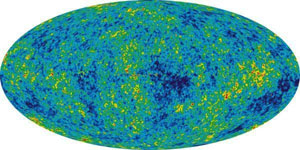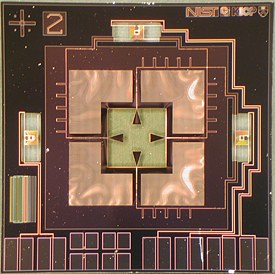Science doesn’t have a lot to say about what happened before the Big Bang, but researchers have now developed microwave detectors that will let them take a look at the first trillionth of a trillionth of a trillionth of a second after that primordial cosmic event.
A collaboration between scientists at the National Institute of Standards and Technology (NIST), Princeton University, the University of Colorado at Boulder, and the University of Chicago has yielded super-sensitive microwave detectors that were revealed at the American Physical Society (APS) April meeting held in Denver during May.

Cosmic microwave temperature fluctuations fill the sky and are an echo of the first moment after the Big Bang (Credit: NASA/WMAP Science Team)
The cosmic microwave background (CMB) is often referred to as the afterglow of creation. This remnant, or echo of the Big Bang fills the universe and various projects have obtained snapshots of the CMB stretching back closer and closer to the Big Bang. The new project will use a large array of the sensors mounted on a telescope mounted in the Chilean desert. They will look for subtle fingerprints of the CMB from primordial gravitational waves, ripples in the fabric of the spacetime continuum. Theory has it that these waves will have left an imprint on the direction of the CMB’s electric field, called the B-mode polarization.
This is one of the great measurement challenges facing the scientific community over the next twenty years, and one of the most exciting ones as well, says Kent Irwin, the NIST physicist leading the project.

Prototype NIST detector that will be used to spot signature of rapid inflation immediately after the Big Bang. (Credit: NIST)
If found, these waves would be the clearest evidence yet in support of the inflation theory, which suggests that all of the currently observable universe expanded rapidly (within the first tiny fraction of a second) from a subatomic volume, leaving in its wake the telltale cosmic background of gravitational waves.
The B-mode polarization is the most significant piece of evidence related to inflation that has yet to be observed, explained NIST’s Ki Won Yoon, at the APS meeting. A detection of primordial gravitational waves through CMB polarization would go a long way toward putting the inflation theory on firm ground.
These types of experiments can only be done by treating the universe as a whole as a cosmic laboratory. The particles and electromagnetic fields that exist immediately after the Big Bang are billions of times more energetic than those available even with the most powerful particle colliders on Earth today. On this energy scale, three of the fundamental forces of nature but excluding gravity, are predicted to merge into a single unified force.
At the energy scale at which inflation occurred, which is the GUT or Grand Unified Theory energy scale, only 3 out of the 4 fundamental forces are predicted to merge into a single unified force – electromagnetism, the strong nuclear force, and the weak nuclear force, Irwin told Spotlight.
The final force of nature, gravity, is not predicted to merge with the other three until a much higher energy scale referred to as the Planck scale, which would have occurred before inflation, and would not have been related to the primordial gravity waves. A theory that correctly incorporates gravity into a unified field is humorously referred to as a TOE or Theory of Everything, he adds.
Further reading
APS April 2009 Meeting
http://www.aps.org/meetings/april/
National Institute of Standards and Technology homepage
http://www.nist.gov/index.html
Suggested searches
Big Bang
cosmology
cosmic microwave background